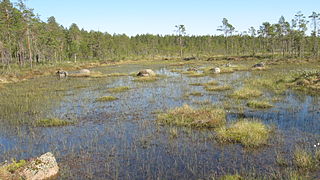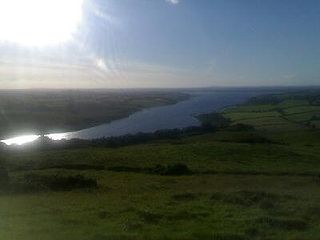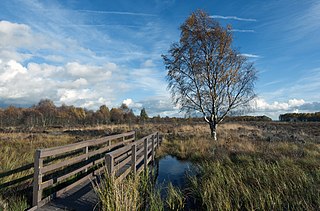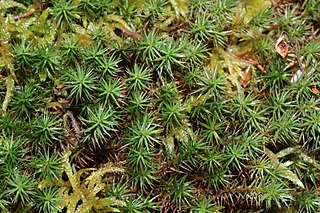
A bog or bogland is a wetland that accumulates peat as a deposit of dead plant materials – often mosses, typically sphagnum moss. It is one of the four main types of wetlands. Other names for bogs include mire, mosses, quagmire, and muskeg; alkaline mires are called fens. A bayhead is another type of bog found in the forest of the Gulf Coast states in the United States. They are often covered in heath or heather shrubs rooted in the sphagnum moss and peat. The gradual accumulation of decayed plant material in a bog functions as a carbon sink.

Risley Moss is an area of peat bog situated near Birchwood in Warrington, England. It is a country park, Site of Special Scientific Interest and a Local Nature Reserve. It covers an area of 210.5 acres (85.2 ha) and is one of the last remaining fragments of the raised bogs that once covered large areas of South Lancashire and North Cheshire.

Sphagnum is a genus of approximately 380 accepted species of mosses, commonly known as sphagnum moss, also bog moss and quacker moss. Accumulations of Sphagnum can store water, since both living and dead plants can hold large quantities of water inside their cells; plants may hold 16 to 26 times as much water as their dry weight, depending on the species. The empty cells help retain water in drier conditions.
Ballynahone Bog is a raised bog, situated in County Londonderry, Northern Ireland, about 3 km south of Maghera, on low-lying ground immediately north of the Moyola River about 14 km from its mouth at Lough Neagh. It is one of the largest lowland raised bogs in Northern Ireland.

Lough Derravaragh is a lake in County Westmeath, Ireland, north of Mullingar between Castlepollard, Crookedwood and Multyfarnham.

Flanders Moss is an area of raised bog lying in the Carse of Forth in west Stirlingshire, Scotland. The villages of Thornhill and Port of Menteith lie to the north with the villages of Kippen and Buchlyvie lying to the south. The moss is a National Nature Reserve, managed by NatureScot. Formed on the Carse of Stirling over 8000 years ago, it is an internationally important habitat currently undergoing active restoration. The eastern part of Flanders Moss is the largest raised bog in Europe to remain in a predominantly near-natural state.

Aulacomnium palustre, the bog groove-moss or ribbed bog moss, is a moss that is nearly cosmopolitan in distribution. It occurs in North America, Hispaniola, Venezuela, Eurasia, and New Zealand. In North America, it occurs across southern arctic, subboreal, and boreal regions from Alaska and British Columbia to Greenland and Quebec. Documentation of ribbed bog moss's distribution in the contiguous United States is probably incomplete. It is reported sporadically south to Washington, Wyoming, Georgia, and Virginia.

Raised bogs, also called ombrotrophic bogs, are acidic, wet habitats that are poor in mineral salts and are home to flora and fauna that can cope with such extreme conditions. Raised bogs, unlike fens, are exclusively fed by precipitation (ombrotrophy) and from mineral salts introduced from the air. They thus represent a special type of bog, hydrologically, ecologically and in terms of their development history, in which the growth of peat mosses over centuries or millennia plays a decisive role. They also differ in character from blanket bogs which are much thinner and occur in wetter, cloudier climatic zones.
Scohaboy Bog is a raised bog in County Tipperary in Ireland. It lies approximately 6 km northwest of Cloughjordan, County Tipperary, between the N52 and R490 roads.

Lough Funshinagh is a lake and Special Area of Conservation in County Roscommon, Ireland, found to the west of Lough Ree. It has been called Ireland's amazing disappearing lake, due to the way it empties quickly - in as little as two days - and unpredictably, sometimes killing thousands of fish. Lough Funshinagh is one of a number of seasonal lakes, or turlough, found in the karst areas of Ireland, west of the River Shannon.
Lough O'Flynn is a freshwater lake in the west of Ireland. It is located in west County Roscommon and is the source of the River Suck.
Errit Lough is a freshwater lake in the west of Ireland. It is located in west County Roscommon in the catchment of the Boyle River. The lake is a Natura 2000 site. It is protected as a Special Area of Conservation since May 2016 under the qualification of a specific habitat type: the presence of ‘Hard Water Lakes’, alternatively known as ‘Hard oligo-mesotrophic waters with benthic vegetation of Chara spp.’

Polytrichum strictum, commonly known as bog haircap moss or strict haircap, is an evergreen and perennial species of moss native to Sphagnum bogs and other moist habitats in temperate climates. It has a circumboreal distribution, and is also found in South America and Antarctica.
Redwood Bog is a raised bog and national nature reserve of approximately 326 acres (1.32 km2) in County Tipperary.
Ballynafagh Lake is a Special Area of Conservation and wildfowl sanctuary in County Kildare, close to the town of Prosperous in County Kildare, Ireland. This site is also known as the Blackwood Reservoir, the Blackwood Lake or the Prosperous Reservoir.
The Red Bog Special Area of Conservation or SAC is a Natura 2000 site in County Kildare, close to the town of Blessington in County Wicklow, Ireland. The qualifying interests by which it is protected as an SAC are the presence of a specific habitat type: transitional mires and quaking bogs.
The Ballynafagh Bog Special Area of Conservation or SAC is a Natura 2000 site in County Kildare, close to the town of Prosperous in County Kildare, Ireland. The three qualifying interests by which this site is protected as an SAC are the presence of active raised bog, of degraded raised bogs still capable of natural regeneration, and of depressions on peat substrates of the Rhynchosporion.
The Four Roads Turlough Special Area of Conservation is a Natura 2000 site based at the village of Four Roads, Ireland, close to Roscommon town, in County Roscommon, Ireland. The Four Roads Turlough is one of a number of seasonal lakes, or turloughs, found in the karst areas of Ireland, west of the River Shannon.
The Bellanagare Bog Special Area of Conservation is a Natura 2000 site based close to the village of Bellanagare and the town of Castlerea in County Roscommon, Ireland. The qualifying interests by which it is protected as an SAC are the presence of three habitat types: the presence of active raised bog, the presence of degraded raised bogs still capable of natural regeneration, and the presence of depressions on peat substrates of Rhynchosporion vegetation.
The Cloonchambers Special Area of Conservation or SAC is a Natura 2000 site based close to the town of Castlerea in County Roscommon, Ireland. The qualifying interests by which it is protected as an SAC are the presence of three habitat types: the presence of active raised bogs, the presence of degraded raised bogs still capable of natural regeneration, and the presence of depressions on peat substrates of Rhynchosporion vegetation.









